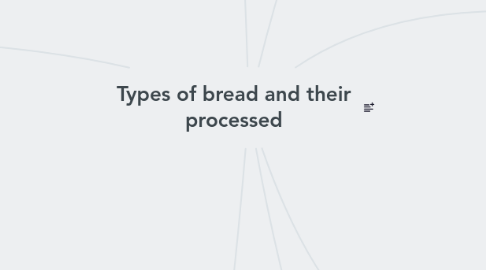
1. Factors that impact in the characteristic of the dough
1.1. Water Content
1.1.1. If there is insufficient water to meet the hydration needs of the entire dough ingredient, the gluten does not become fully hydrated and the elastic nature of the dough does not become fully developed. Conversely, an excessive level of free water in the dough results in the domination of the viscous component of dough, with a decreased resistance to extension, increased extensibility and the development of sticky dough
1.2. Air
1.2.1. Dough mixed in the presence of oxygen is more elastic an more resistance to the extension than those mixed in the absence of oxygen
1.3. Salt
1.3.1. Salt changes water interactions between components and it alters the configuration of gluten proteins, because of its composition for water. The combination of these actions results in increased mixing time for the dough
1.4. Sodium caseinate and Whey protein.
1.4.1. Addition of 4% sodium caseinate decreases resistance to extension, while adding 4% whey protein concentrate increases extensibility. Whey protein concentrate also decreases storage modulus and loss modulus, while heat treatment of whey protein concentrate increases Storage modulus and loss modulus. Confocal laser scanning microscopy showed that milk proteins cause increasing in gluten network compared with the control, while un-treated whey protein concentrate appears to interfere with the gluten network.
1.5. Fiber and added fat
1.5.1. Adding fiber to dough increases P in alveograph (dough resistance to deformation or tenacity). This is likely due to interactions between the fiber structure and the wheat proteins. Additionally, parameter in alveograph (stands for the height of the bubble that was achieved, measured from where the slop of the bubble started to the top of the bubble and shows how flexible the dough was) decreases by adding most of the dough. Likewise, added fats have plasticizing effect on storage modulus and loss modulus in elastic region. Addition of fat delays viscous flow.
2. Ingredients
2.1. Water
2.1.1. -The 2nd main ingredient for making dough -Hydrates the dough and creates its consistency -Facilitates gluten formation by hydration of the dough
2.2. Salt
2.2.1. -The main objective is giving flavor to bread -Makes the dough tougher -Acts as a regulator of fermentation -It favors the coloration of the crust during cooking -Increases the water retention capacity of bread
2.3. Flour
2.3.1. Normally made from the mealing of wheat endosperm Humidity: 13 – 15% Proteins: 9 – 14% (85 % gluten) Starch: 68 -72% Minerals: 0.5 – 0.65%
3. Members of the group
3.1. Jimena Galdos
3.2. Pablo Vasquez
3.3. Karen Ugarte
4. Methods for breadmaking
4.1. Sponge- and- dough method
4.1.1. Mixing is done in 2 steps. Leavening agent is prepared during the first step. Yeast and certain quantity of water and flour are mixed together. The mixture is left to develop for few hours and afterwards it is mixed with the rest of the ingredients.
4.2. The straight dough method
4.2.1. Mixing is done in one step.
4.3. No-Time method
4.3.1. All the ingredients are mixed in an ultrahigh mixer for few minutes and then the dough is almost directly sent to the divider machine.
4.4. Continuous method
4.4.1. All stages (from kneading to cooking) are carried out without interruption. useful for the high production of a single type of bread
